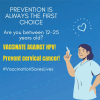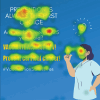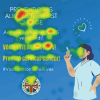The influence of national origin cues in HPV vaccination advertising: An eye-tracking study of visual attention and vaccine perception using quantitative and qualitative analysis
- PMID: 40400132
- PMCID: PMC12101603
- DOI: 10.1080/21645515.2025.2506865
The influence of national origin cues in HPV vaccination advertising: An eye-tracking study of visual attention and vaccine perception using quantitative and qualitative analysis
Abstract
This study is among the first to investigate how national origin cues influence visual attention and perception in HPV vaccine advertisements, using eye-tracking technology to provide objective insights into consumer responses. By integrating methods from public health, psychology, and advertising research, this study explores how visual attention is shaped by national affiliation cues. In a controlled experimental setting with a sample of 40 UK university students, we investigated visual attention and effectiveness of HPV vaccination advertisements by comparing ads disclosing the national origin of the vaccine and without any origin information. We assessed total fixation duration and time to first fixation to various elements of the ad, along with intention and attitude measures. Contrary to one of our hypotheses, we did not find significant differences in intention (p = .758) and attitude (p = .620) measures. However, there was significant difference in total fixation duration toward one of the ad images between conditions (p = .043). The qualitative analysis reveals the role of country-of-origin (COO) in HPV vaccination advertising, suggesting a shift in attention from that image to the COO cue. Furthermore, eight out of the 20 participants in the treatment condition did not fixate at the COO cue. Findings provide critical insights for public health communication strategies, suggesting that the use (or omission) of national origin cues in vaccine advertisements could influence vaccine perception and hesitancy. These results highlight the need for strategic messaging approaches to enhance HPV vaccine acceptance and improve public trust in domestic and international vaccines.
Keywords: HPV prevention; HPV vaccine; Vaccine hesitancy; country-of-origin cue; country-of-origin effect; domestic vaccines; eye-tracking; national vaccines; visual attention during advertising.
Conflict of interest statement
No potential conflict of interest was reported by the author(s).
Figures




Similar articles
-
Factors influencing HPV vaccine hesitancy among university students in China: A cross-sectional survey utilizing the 3Cs model.Hum Vaccin Immunother. 2024 Dec 31;20(1):2400750. doi: 10.1080/21645515.2024.2400750. Epub 2024 Sep 17. Hum Vaccin Immunother. 2024. PMID: 39288789 Free PMC article.
-
Exploring human papillomavirus vaccine hesitancy among college students and the potential of virtual reality technology to increase vaccine acceptance: a mixed-methods study.Front Public Health. 2024 Feb 13;12:1331379. doi: 10.3389/fpubh.2024.1331379. eCollection 2024. Front Public Health. 2024. PMID: 38414894 Free PMC article.
-
Factors Influencing Knowledge and Acceptance of Nonavalent Human Papillomavirus Vaccine Among University Population in Southern China: A Cross-Sectional Study.Cancer Control. 2024 Jan-Dec;31:10732748241293989. doi: 10.1177/10732748241293989. Cancer Control. 2024. PMID: 39435865 Free PMC article.
-
Human papillomavirus vaccination hesitancy among young girls in Ethiopia: factors and barriers to uptake.Front Public Health. 2025 Jan 23;13:1507832. doi: 10.3389/fpubh.2025.1507832. eCollection 2025. Front Public Health. 2025. PMID: 39916703 Free PMC article.
-
HPV vaccination in a context of public mistrust and uncertainty: a systematic literature review of determinants of HPV vaccine hesitancy in Europe.Hum Vaccin Immunother. 2019;15(7-8):1615-1627. doi: 10.1080/21645515.2018.1564436. Epub 2019 Feb 20. Hum Vaccin Immunother. 2019. PMID: 30633623 Free PMC article.
References
MeSH terms
Substances
LinkOut - more resources
Full Text Sources
Medical
